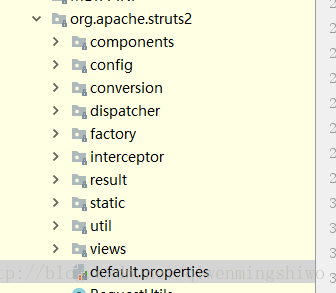- SSH与SSM学习之Struts203主配置文件配置常量配置动态方法配置_action书写方式
- 一主配置文件 strutsxml 配置
- 1 strutsxml配置文件示例
- 2 package
- 3 action
- 4 result
- 二常量配置
- 1 Struts2默认常量配置文件的位置
- 2 常量配置方式一strutsxml中配置
- 3 常量配置方式二strutsproperties中配置
- 4 常量配置方式三webxml中配置
- 5 常量配置的加载顺序
- 三 动态方法调用配置
- 1 创建我们的类和配置文件
- 2 动态方法调用方式1 配置常量
- 3 动态方法调用方式2 通配符匹配
- 4 struts25动态调用配置额外的必须的配置
- 四Struts2 默认配置
- 五action书写方式
- 1 action书写方式一简单的类
- 2 action书写方式二实现Action接口
- 3 action书写方式三继承ActionSupport
- 一主配置文件 strutsxml 配置
SSH与SSM学习之Struts203——主配置文件配置常量配置动态方法配置_action书写方式
一、主配置文件 struts.xml 配置
1.1 struts.xml配置文件示例
<?xml version="1.0" encoding="UTF-8" ?>
<!DOCTYPE struts PUBLIC
"-//Apache Software Foundation//DTD Struts Configuration 2.3//EN"
"http://struts.apache.org/dtds/struts-2.3.dtd">
<struts>
<package name="test" namespace="/test" extends="struts-default">
<action name="TestDemo1Action" class="com.qwm.struts2_1.testdemo.TestDemo1Action" method="test1">
<result name="success">/hello.jsp</result>
</action>
</package>
<include file="com/qwm/struts2_1/dynamic/struts.xml"/>
</struts>1.2 package
<!--
package:将action配置封装,就是可以在packege中配置很多action
name:给包起个名字,起到标识的作用,可以任意取名,不能与其他包重名
namespace:给actionde的访问路径定义一个命名空间
extends:继承一个指定包 默认继承 struts-default
abstract:包是否为抽象的,标示性属性,标识该包不能独立运行,专为继承
-->
<package name="test" namespace="/test" extends="struts-default">
</package>1.3 action
<!--
action元素:配置action类
name:决定了action访问资源名
class:action的完成类名
method:制定调用action中的哪个方法来处理
-->
<action name="TestDemo1Action" class="com.qwm.struts2_1.testdemo.TestDemo1Action" method="test1">
<result name="success">/hello.jsp</result>
</action>1.4 result
<!--
action元素:配置action类
name:决定了action访问资源名
class:action的完成类名
method:制定调用action中的哪个方法来处理
-->
<action name="TestDemo1Action" class="com.qwm.struts2_1.testdemo.TestDemo1Action" method="test1">
<!--
result元素:结果配置
name:标识结果处理的名字,与action方法的返回值对应
type:制定调用哪一个result类来处理结果,默认使用转发
标签体:填写页面的相对路径
-->
<result name="success">/hello.jsp</result>
</action>二、常量配置
2.1 Struts2默认常量配置文件的位置
Struts2默认常量配置文件的位置 是在我们的Struts2的核心包内。比如我的版本是 2.5.13
我们的核心包是struts2-core-2.5.13.jar,我的Struts2默认常量配置文件的位置是
struts2-core-2.5.13.jar!orgapachestruts2default.properties图示

2.2 常量配置方式一struts.xml中配置
配置常量的标签是 constant
比如我我们现在要来配置 国际化(i18n)的编码为utf-8。
打开我们的 src/struts.xml 文件,在struts标签下配置 i18n 的编码。配置如下
<!--国际化编码配置,可以解决POST请求乱码-->
<constant name="struts.i18n.encoding" value="UTF-8"/>我们的 struts.xml 配置文件
<?xml version="1.0" encoding="UTF-8" ?>
<!DOCTYPE struts PUBLIC
"-//Apache Software Foundation//DTD Struts Configuration 2.3//EN"
"http://struts.apache.org/dtds/struts-2.3.dtd">
<struts>
<!--开启开发模式-->
<constant name="struts.devMode" value="true"/>
<!--国际化编码配置,可以解决POST请求乱码-->
<constant name="struts.i18n.encoding" value="UTF-8"/>
<!--
package:将action配置封装,就是可以在packege中配置很多action
name:给包起个名字,起到标识的作用,可以任意取名,不能与其他包重名
namespace:给actionde的访问路径定义一个命名空间
extends:继承一个指定包 默认继承 struts-default
abstract:包是否为抽象的,标示性属性,标识该包不能独立运行,专为继承
-->
<package name="test" namespace="/test" extends="struts-default">
<!--
action元素:配置action类
name:决定了action访问资源名
class:action的完成类名
method:制定调用action中的哪个方法来处理
-->
<action name="TestDemo1Action" class="com.qwm.struts2_1.testdemo.TestDemo1Action" method="test1">
<!--
result元素:结果配置
name:标识结果处理的名字,与action方法的返回值对应
type:制定调用哪一个result类来处理结果,默认使用转发
标签体:填写页面的相对路径
-->
<result name="success">/hello.jsp</result>
</action>
</package>
<!--引入其他sttuts配置文件-->
<include file="com/qwm/struts2_1/dynamic/struts.xml"/>
</struts>2.3 常量配置方式二struts.properties中配置
在 src 下创建 struts.properties,配置如下
struts.i18n.encoding=UTF-82.4 常量配置方式三web.xml中配置
打开我们项目的 web.xml 文件,在下配置 。配置如下
<?xml version="1.0" encoding="UTF-8"?>
<web-app xmlns="http://xmlns.jcp.org/xml/ns/javaee"
xmlns:xsi="http://www.w3.org/2001/XMLSchema-instance"
xsi:schemaLocation="http://xmlns.jcp.org/xml/ns/javaee http://xmlns.jcp.org/xml/ns/javaee/web-app_3_1.xsd"
version="3.1">
<context-param>
<param-name>struts.i18n.encoding</param-name>
<param-value>UTF-8</param-value>
</context-param>
<!--struts2核心过滤器配置-->
<filter>
<filter-name>struts2</filter-name>
<filter-class>org.apache.struts2.dispatcher.filter.StrutsPrepareAndExecuteFilter</filter-class>
</filter>
<filter-mapping>
<filter-name>struts2</filter-name>
<url-pattern>/*</url-pattern>
</filter-mapping>
</web-app>
2.5 常量配置的加载顺序
常量的顺序如下
1. struts.xml
2. struts.properties
3. web.xml
那么很容易得出,如果我们在三个文件中配置了同一个常量,那么最后我们获取到的绝对是 web.xml 配置的值。
三、 动态方法调用配置
有的时候,我们的action方法很多,如果我们为每个方法都添加一个action那么挺麻烦的。这个时候,我们就可以使用动态配置的方法是了。
3.1 创建我们的类和配置文件
我们创建一个包 com.qwm.struts2_1.dynamic,在这个包下创建DynamicDemo1Action.java 和 struts.xml(可以取别的名称)。写我们的方法,和配置我们的配置文件。
DynamicDemo1Action.java
package com.qwm.struts2_1.dynamic;
/**
* @author: wiming
* @date: 2017-09-18 13:41:20 星期一
* @decription:
* 动态调用方法配置
*/
public class DynamicDemo1Action {
public String add(){
System.out.println("添加用户!");
return "success";
}
public String delete(){
System.out.println("删除用户!");
return "success";
}
public String update(){
System.out.println("修改用户!");
return "success";
}
public String find(){
System.out.println("查找用户!");
return "success";
}
}
comqwmstruts2_1dynamicstruts.xml
<?xml version="1.0" encoding="UTF-8"?>
<!DOCTYPE struts PUBLIC
"-//Apache Software Foundation//DTD Struts Configuration 2.5//EN"
"http://struts.apache.org/dtds/struts-2.5.dtd">
<struts>
<package name="dynamic" namespace="/dynamic" extends="struts-default">
<action name="DynamicAction" class="com.qwm.struts2_1.dynamic.DynamicDemo1Action" method="add">
<result name="success">/hello.jsp</result>
</action>
</package>
</struts>我们需要把我们上面的配置文件,添加到主配置文件 srcstruts.xml中。
<!--引入其他sttuts配置文件-->
<include file="com/qwm/struts2_1/dynamic/struts.xml"/>这个时候,我们能够访问我们的 add 方法了,这是毫无疑问的。但是我们需要动态调用。
3.2 动态方法调用方式1 配置常量
我们现在开始第一种方式的配置,在我们的 comqwmstruts2_1dynamicstruts.xml配置文件中,添加动态方法调用的常量配置即可
<!-- 配置动态方法调用是否开启常量
默认是关闭的,需要开启
-->
<constant name="struts.enable.DynamicMethodInvocation" value="false"/>我们的配置文件就成为以下这样了
<?xml version="1.0" encoding="UTF-8"?>
<!DOCTYPE struts PUBLIC
"-//Apache Software Foundation//DTD Struts Configuration 2.5//EN"
"http://struts.apache.org/dtds/struts-2.5.dtd">
<struts>
<!-- 配置动态方法调用是否开启常量
默认是关闭的,需要开启
-->
<constant name="struts.enable.DynamicMethodInvocation" value="false"/>
<package name="dynamic" namespace="/dynamic" extends="struts-default">
<!--全局允许方法调用-->
<global-allowed-methods>regex:.*</global-allowed-methods>
<action name="DynamicAction" class="com.qwm.struts2_1.dynamic.DynamicDemo1Action">
<result name="success">/hello.jsp</result>
</action>
</package>
</struts>现在配置好了,部署我们的服务器,我们现在就可以在浏览器中访问我们action的方法了。
访问方式
!方法名例如:
我们访问 http://localhost:8080/s2_1/dynamic/DynamicAction!add
后台打印结果
添加用户!我们访问 http://localhost:8080/s2_1/dynamic/DynamicAction!delete
后台打印结果
删除用户!我们访问 http://localhost:8080/s2_1/dynamic/DynamicAction!update
后台打印结果
修改用户!我们访问 http://localhost:8080/s2_1/dynamic/DynamicAction!find
后台打印结果
查找用户!3.3 动态方法调用方式2 通配符匹配
这种方式的配置,我们不需要配置使用上面提到的常量。只需要对aciton的name和method修改就行了。例如
<action name="DynamicAction_*" class="com.qwm.struts2_1.dynamic.DynamicDemo1Action" method="{1}">使用{1} 取出第一个星号通配的内容。其中DynamicAction_*中的 也可以是 #,或者其他符号,只是习惯使用 ,那么我们的配置文件就成为下面这样的了
<?xml version="1.0" encoding="UTF-8"?>
<!DOCTYPE struts PUBLIC
"-//Apache Software Foundation//DTD Struts Configuration 2.5//EN"
"http://struts.apache.org/dtds/struts-2.5.dtd">
<struts>
<package name="dynamic" namespace="/dynamic" extends="struts-default">
<!--全局允许方法调用-->
<global-allowed-methods>regex:.*</global-allowed-methods>
<!-- 动态方法调用方式2:通配符方式
使用{1} 取出第一个星号通配的内容
-->
<action name="DynamicAction_*" class="com.qwm.struts2_1.dynamic.DynamicDemo1Action" method="{1}">
<result name="success">/hello.jsp</result>
</action>
</package>
</struts>访问方式 (“_”是我们配置的)
_方法名例如:
我们访问 http://localhost:8080/s2_1/dynamic/DynamicAction_add
后台打印结果
添加用户!我们访问 http://localhost:8080/s2_1/dynamic/DynamicAction_delete
后台打印结果
删除用户!我们访问 http://localhost:8080/s2_1/dynamic/DynamicAction_update
后台打印结果
修改用户!我们访问 http://localhost:8080/s2_1/dynamic/DynamicAction_find
后台打印结果
查找用户!3.4 struts2.5动态调用配置额外的必须的配置
struts2.5 为了提升安全性,添加了allomethod这个配置。我们的动态调用想要成功,必须加上这个配置
“`
<global-allowed-methods>regex:.*</global-allowed-methods>
<action ....>
...
</action>
“`
或者,针对action,在 action 块中添加
<allowed-methods>regex:.*</allowed-methods>同样也支持在你的 action 上使用 @AllowedMethods 注解
默认的设置我们可以来到 struts2-core-2.5.13.jar!struts-default.xml 中查看,如下
<global-allowed-methods>execute,input,back,cancel,browse,save,delete,list,index</global-allowed-methods>四、Struts2 默认配置
default-action-ref 标签,可以设置我们默认的 action,再找不到我们 包下的action的时候,会调用我们默认的 ation。
如果我们不配置,Struts2默认是 com.opensymphony.xwork2.ActionSupport
<!-- 找不到包下的action,会使用Demo2Action作为默认action处理请求 -->
<default-action-ref name="Demo2Action"></default-action-ref>下面是一些默认值。
action中的默认值
method属性: execute
class属性:com.opensymphony.xwork2.ActionSupport
result的name属性:success
result的type属性:dispatcher 转发
我们由上面知道,我们的Struts2的默认配置文件是:struts2-core-2.5.13.jar!struts-default.xml
....
<package name="struts-default" abstract="true" strict-method-invocation="true">
<result-types>
<result-type name="chain" class="com.opensymphony.xwork2.ActionChainResult"/>
<!--默认是转发-->
<result-type name="dispatcher" class="org.apache.struts2.result.ServletDispatcherResult" default="true"/>
<result-type name="freemarker" class="org.apache.struts2.views.freemarker.FreemarkerResult"/>
<result-type name="httpheader" class="org.apache.struts2.result.HttpHeaderResult"/>
<result-type name="redirect" class="org.apache.struts2.result.ServletRedirectResult"/>
<result-type name="redirectAction" class="org.apache.struts2.result.ServletActionRedirectResult"/>
<result-type name="stream" class="org.apache.struts2.result.StreamResult"/>
<result-type name="velocity" class="org.apache.struts2.result.VelocityResult"/>
<result-type name="xslt" class="org.apache.struts2.views.xslt.XSLTResult"/>
<result-type name="plainText" class="org.apache.struts2.result.PlainTextResult" />
<result-type name="postback" class="org.apache.struts2.result.PostbackResult" />
</result-types>
....
<default-class-ref class="com.opensymphony.xwork2.ActionSupport" />
<global-allowed-methods>execute,input,back,cancel,browse,save,delete,list,index</global-allowed-methods>
</package>
....ActionSupport.java
public class ActionSupport implements Action, Validateable, ValidationAware, TextProvider, LocaleProvider, Serializable {
.....
public String execute() throws Exception {
return SUCCESS;
}
....
}Action.java
public interface Action {
public static final String SUCCESS = "success";
public static final String NONE = "none";
public static final String ERROR = "error";
public static final String INPUT = "input";
public static final String LOGIN = "login";
public String execute() throws Exception;
}五、action书写方式
5.1 action书写方式一、简单的类
例如
//方式1: 创建一个类.可以是POJO
//POJO:不用继承任何父类.也不需要实现任何接口.
//使struts2框架的代码侵入性更低.
public class Demo1Action {
.....
}
5.2 action书写方式二、实现Action接口
例如
import com.opensymphony.xwork2.Action;
//方式2: 实现一个接口Action
// 里面有execute方法,提供action方法的规范.
// Action接口预置了一些字符串.可以在返回结果时使用.为了方便
public class Demo2Action implements Action {
@Override
public String execute() throws Exception {
return null;
}
....
}
5.3 action书写方式三、继承ActionSupport
常用这种。
例如
import com.opensymphony.xwork2.ActionSupport;
//方式3: 继承一个类.ActionSupport
// 帮我们实现了 Validateable, ValidationAware, TextProvider, LocaleProvider .
//如果我们需要用到这些接口的实现时,不需要自己来实现了.
public class Demo3Action extends ActionSupport{
....
}
最后
以上就是简单金毛最近收集整理的关于SSH与SSM学习之Struts203——主配置文件配置_常量配置_动态方法配置_action书写方式SSH与SSM学习之Struts203——主配置文件配置常量配置动态方法配置_action书写方式的全部内容,更多相关SSH与SSM学习之Struts203——主配置文件配置_常量配置_动态方法配置_action书写方式SSH与SSM学习之Struts203——主配置文件配置常量配置动态方法配置_action书写方式内容请搜索靠谱客的其他文章。








发表评论 取消回复